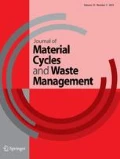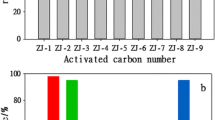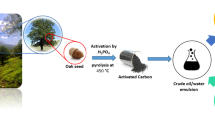Abstract
In this study, an agricultural bio-waste, corncob, was used as an effective adsorbent for the removal of crude oil in aqueous solution. The adsorption efficiency of crude oil in natural corncob (NCC) and powdered corncob (PCC) was examined. In addition, the crude oil adsorption behavior is discussed, and the kinetic models used suggest that the sorption process occurs via a surface reaction. Equilibrium isotherm data were analyzed using the Langmuir, Freundlich, and Dubinin–Radushkevich isotherms. Based on the regression coefficients, the Langmuir isotherm shows a better fit to the data. The maximum adsorption capacities were 4.21 g/g and 7.80 g/g for NCC and PCC, respectively. The adsorption energy obtained was 5.143 kJ/mol for NCC and 5.768 kJ/mol for PCC. Based on these results, crude oil adsorption using corncob was a physical process. Moreover, the value of 1/n was 0.462 for NCC and 0.359 for PCC; hence, the adsorption of crude oil using corncob was very favorable. The thermodynamic analysis showed that Gibbs free energy (ΔG) and enthalpy (ΔH) were both negative, and the adsorption process was exothermic and spontaneous. Due to its low cost, biodegradability, and high adsorptivity, corncob could be considered as a new alternative adsorbent.





Similar content being viewed by others
References
Duke NC (2016) Oil spill impacts on mangroves: Recommendations for operational planning and action based on a global review. Mar Pollut Bull 109(2):700–715
Pasila A (2004) A biological oil adsorption filter. Mar Pollut Bull 9:1006–1012
Singh V, Kendall RJ, Hake K, Ramkumar S (2013) Crude oil sorption by raw cotton. Ind Eng Chem Res 52:6277–6281
Afenyo M, Khan F, Veitch B, Yang M (2017) A probabilistic ecological risk model for Arctic marine oil spills. J Environ Chem Eng 5(2):494–1503
Jung DW, Kim JA, Park MS, Yim UH, Choi KH (2017) Human health and ecological assessment programs for hebei spirit oil spill accident of 2007: status, lessons, and future challenges. Chemosphere 173:180–189
National Security Agency (2016) Administrative data of marine security safety headquarters. National Security Agency, Seoul
Khade V, Kurian J, Chang P, Szunyogh I, Thyng K, Montuoro R (2017) Oceanic ensemble forecasting in the Gulf of Mexico: an application to the case of the deep water horizon oil spill. Ocean Model 113:171–184
Bejarano AC, Michel J (2016) Oil spills and their impacts on sand beach invertebrate communities: a literature review. Environ Pollut 218:709–722
Spaulding ML (2017) State of the art review and future directions in oil spill modeling. Mar Pollut Bull 115(1–2):7–19
Zheng H, Zhu G, Jiang S, Tshukudu T, Xiang X, Zhang P, He Q (2011) Investigations of coagulation–flocculation process by performance optimization, model prediction and fractal structure of flocs. Desalination 269:148–156
Dong T, Xu G, Wang F (2015) Adsorption and adhesiveness of kapok fiber to different oils. J Hazard Mater 296:101–111
Ogbu JO, Ajiwe VIE, Okoye PAC (2016) Removal of crude oil from aqueous medium by adsorption on hydrophobic corncobs: equilibrium and kinetics studies. J Taibah Univ Sci 10:56–63
Banerjee SS, Joshi MV, Jayaram RV (2006) Treatment of oil spill by sorption techniques using fatty acid grafted sawdust. Chemosphere 64:1026–1031
Barati AB, Najafi A, Daryasafar A, Nadali P, Moslehi H (2016) Adsorption of a new nonionic surfactant on carbonate minerals in enhanced oil recovery: experimental and modeling study. Chem Eng Res Des 105:55–63
Angelova D, Uzunov I, Uzunovz S, Gigova A, Minchev L (2011) Kinetics of oil and oil products adsorption by carbonized rice husks. Chem Eng J 172:306–311
Nwadiogbu JO, Ajiwe VIE, Okoye PAC (2016) Removal of crude oil from aqueous medium by sorption on hydrophobic corncobs: equilibrium and kinetic studies. J Taibah Univ Sci 10:56–63
Leyva-Ramos R, Landin-Rodriguez LE, Leyva-Ramos S, Medellin-Castillo NA (2012) Modification of corncob with citric acid to enhance its capacity for adsorbing cadmium (II) from water solution. Chem Eng J 180:113–120
Choi HJ (2017) Application of corncob for treatment of Cu(II) in aqueous solution. KSWAT J Water Treat 25(2):61–72
APHA (2015) APHA standard methods for the examonation of water and wastewater. American Public Health Association, Washington DC
Azubuike CP, Okhamafe AO (2012) Physicochemical, spectroscopic and thermal properties of microcrystalline cellulose derived from corn cobs. Int J Recycl Org Waste Agric 1:9
Lee SY, Choi HJ (2018) Persimmon leaf bio-waste for adsorptive removal of heavy metals from aqueous solution. J Environ Manag 209:382–392
Choi HJ, Yu SW, Kim KH (2016) Efficient use of Mg-modified zeolite in the treatment of aqueous solution contaminated with heavy metal toxic ions. J Taiwan Inst Chem Eng 63:482–489
Sidik SM, Jalil AA, Triwahyono S, Adam SH, Satar MAH, Hameed BH (2012) Modified oil palm leaves adsorbent with enhanced hydrophobicity for crude oil removal. Chem Eng J 203:9–18
Zhong J, Wang P, Zhang Y, Yan Y, Hu S, Zhang J (2013) Adsorption mechanism of oil components on water-wet mineral surface: a molecular dynamics simulation study. Energy 59:295–300
Ali N, El-Harbawi M, Jabal AA, Yin CY (2012) Characteristics and oil sorption effectiveness of kapok fiber, sugarcane bagasse and rice husks: oil removal suitability matric. Environ Technol 33:481–486
Okiel K, El-Sayed M, El-Kady MY (2011) Treatment of oil-water emulsions by adsorption onto activated carbon, bentonite and deposited carbon. Egypt J Pet 20:9–15
Tiwari S, Gupta VK, Pandey P, Singh H, Mishra P (2009) Adsorption chemistry of oil-in-water emulsion from spent oil based cutting fluids using sawdust of mangifera indica. J Int Environ Appl Sci 4:99–107
Nwankwere ET, Gimba CE, Kagbu JA, Nale BK (2010) Sorption studies of crude oil on acetylated rice husks. Adv Appl Sci Res 2:142–145
Hu JQ, Yang SZ, Guo L, Xu X, Yao T, Xie F (2017) Microscopic investigation on the adsorption of lubrication oil on microplastics. J Mol Liq 227:351–355
Oribayo O, Feng X, Rempel GL, Pan Q (2017) Synthesis of lignin-based polyurethane/graphene oxide foam and its application as an absorbent for oil spill clean-ups and recovery. Chem Eng J 323:191–202
Ibrahim S, Wang S, Ang HM (2010) Removal of emulsified oil from oily wastewater using agricultural waste barley straw. Biochem Eng J 49:78–83
Augusta P, Kalaichelvi P (2013) Study on removal of emulsified oil from coolant wastewater using corn husk. In: Proc. of int. conf. on emerging trends in engineering and technology, pp 1–4. https://doi.org/03.AETS.2013.3.153
Srinivasan A, Viraraghavan T (2008) Removal of oil by walnut shell media. Bioresour Technol 99:8217–8220
Acknowledgements
This study was supported by the Basic Science Research Program through the National Research Foundation (NRF) of Korea, funded by the Ministry of Education, Science, and Technology (2016005271).
Author information
Authors and Affiliations
Corresponding author
Ethics declarations
Conflict of interest
No potential conflict of interest was reported by the authors.
Rights and permissions
About this article
Cite this article
Choi, HJ. Agricultural bio-waste for adsorptive removal of crude oil in aqueous solution. J Mater Cycles Waste Manag 21, 356–364 (2019). https://doi.org/10.1007/s10163-018-0797-3
Received:
Accepted:
Published:
Issue Date:
DOI: https://doi.org/10.1007/s10163-018-0797-3




